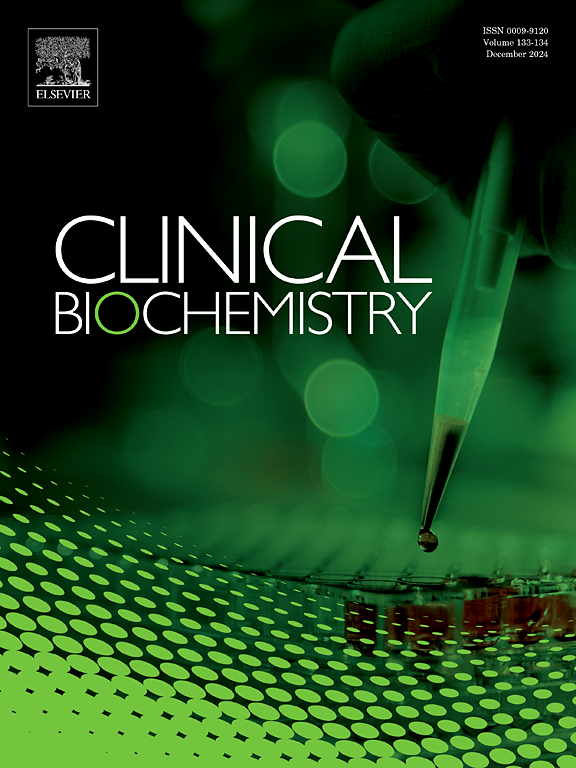CL AIA-PACK®hs-E2是一种使用抗免疫复合物抗体的高灵敏度雌二醇三明治免疫分析法,其分析性能和临床评价
IF 2.1
3区 医学
Q2 MEDICAL LABORATORY TECHNOLOGY
引用次数: 0
摘要
CL AIA-PACK®hs-E2 (hs-E2)是一种采用抗免疫复合物抗体的高灵敏度雌二醇(E2)三明治免疫分析法。本研究旨在评估其在芳香酶抑制剂治疗和儿科内分泌学相关的低浓度范围内的分析性能和临床应用,其中准确的E2测量在临床上很重要。方法对hs-E2测定法的精密度、线性度、灵敏度和干扰度进行评价。将其性能与传统的竞争性免疫分析法(Elecsys®E2)和液相色谱-串联质谱法(LC-MS/MS)进行比较。在接受选择性雌激素受体调节剂或芳香化酶抑制剂治疗的雌激素受体阳性乳腺癌患者中测量雌二醇水平以评估其临床适用性。结果该方法精密度高(CVs < 6.4%),在较宽的浓度范围内线性良好。检测限和定量限分别为4.84和7.11 pmol/L (10% CV)。偶联胆红素诱导E2测量值轻度浓度依赖性降低。在低浓度范围内,hs-E2与LC-MS/MS具有较强的相关性(r = 0.998),而在147 pmol/L以下,Elecsys的相关性较弱。在乳腺癌患者中,hs-E2显示了不同治疗组E2水平的显著差异,这是Elecsys检测无法检测到的。结论采用抗免疫复合物抗体对hs-E2进行免疫分析,在低浓度范围内具有较高的灵敏度和精密度。它与LC-MS/MS的强一致性和增强的临床鉴别支持其在激素治疗的乳腺癌患者和其他低E2临床条件下监测E2水平的实用性。本文章由计算机程序翻译,如有差异,请以英文原文为准。
Analytical performance and clinical evaluation of CL AIA-PACK® hs-E2, a high-sensitivity estradiol sandwich immunoassay using an anti-immunocomplex antibody
Introduction
The CL AIA-PACK® hs-E2 (hs-E2) is a high-sensitivity estradiol (E2) sandwich immunoassay employing an anti-immunocomplex antibody. This study aimed to evaluate its analytical performance and clinical utility at low concentration ranges relevant to aromatase inhibitor therapy and pediatric endocrinology, where accurate E2 measurement is clinically important.
Methods
The hs-E2 assay was evaluated for its precision, linearity, sensitivity, and interference. Its performance was compared with a conventional competitive immunoassay (Elecsys® E2) and liquid chromatography–tandem mass spectrometry (LC-MS/MS). Estradiol levels were measured in patients with estrogen receptor-positive breast cancer receiving selective estrogen receptor modulator or aromatase inhibitor therapy to assess clinical applicability.
Results
The assay showed excellent precision (CVs < 6.4 %) and linearity across a broad concentration range. The limit of detection and limit of quantification were 4.84 and 7.11 pmol/L (10 % CV), respectively. Conjugated bilirubin induced a mild concentration-dependent decrease in measured E2 values. The hs-E2 assay showed a strong correlation with LC-MS/MS, even at low concentration ranges (r = 0.998), while Elecsys showed a weaker correlation below 147 pmol/L. In breast cancer patients, hs-E2 revealed significant differences in E2 levels across treatment groups, which were not detectable by the Elecsys assay.
Conclusions
The hs-E2 immunoassay using an anti-immunocomplex antibody exhibited superior analytical sensitivity and precision at low concentration ranges to conventional methods. Its strong agreement with LC-MS/MS and enhanced clinical discrimination support its utility in monitoring E2 levels in hormone-treated breast cancer patients and other low-E2 clinical conditions.
求助全文
通过发布文献求助,成功后即可免费获取论文全文。
去求助
来源期刊

Clinical biochemistry
医学-医学实验技术
CiteScore
5.10
自引率
0.00%
发文量
151
审稿时长
25 days
期刊介绍:
Clinical Biochemistry publishes articles relating to clinical chemistry, molecular biology and genetics, therapeutic drug monitoring and toxicology, laboratory immunology and laboratory medicine in general, with the focus on analytical and clinical investigation of laboratory tests in humans used for diagnosis, prognosis, treatment and therapy, and monitoring of disease.
 求助内容:
求助内容: 应助结果提醒方式:
应助结果提醒方式:


